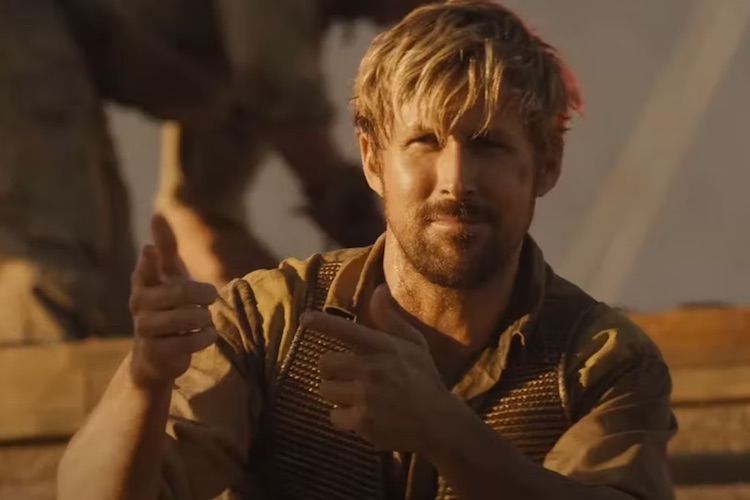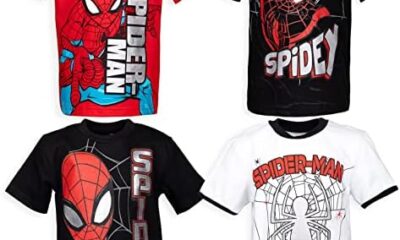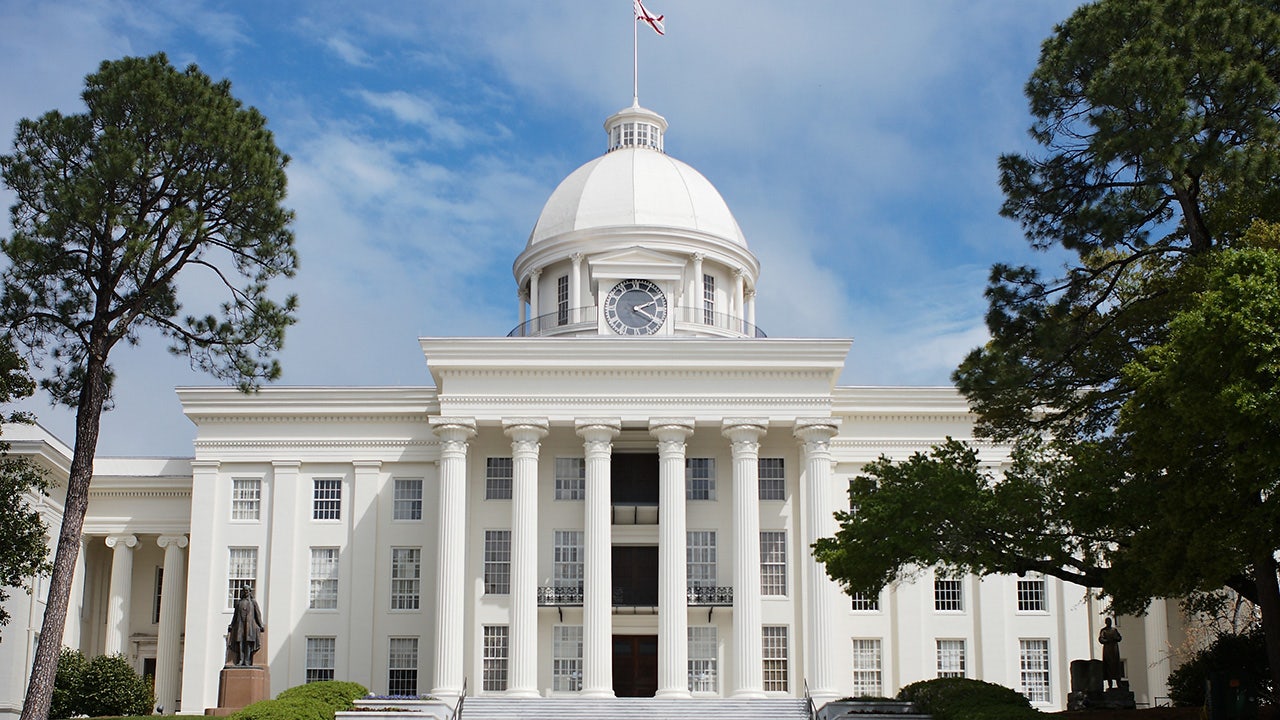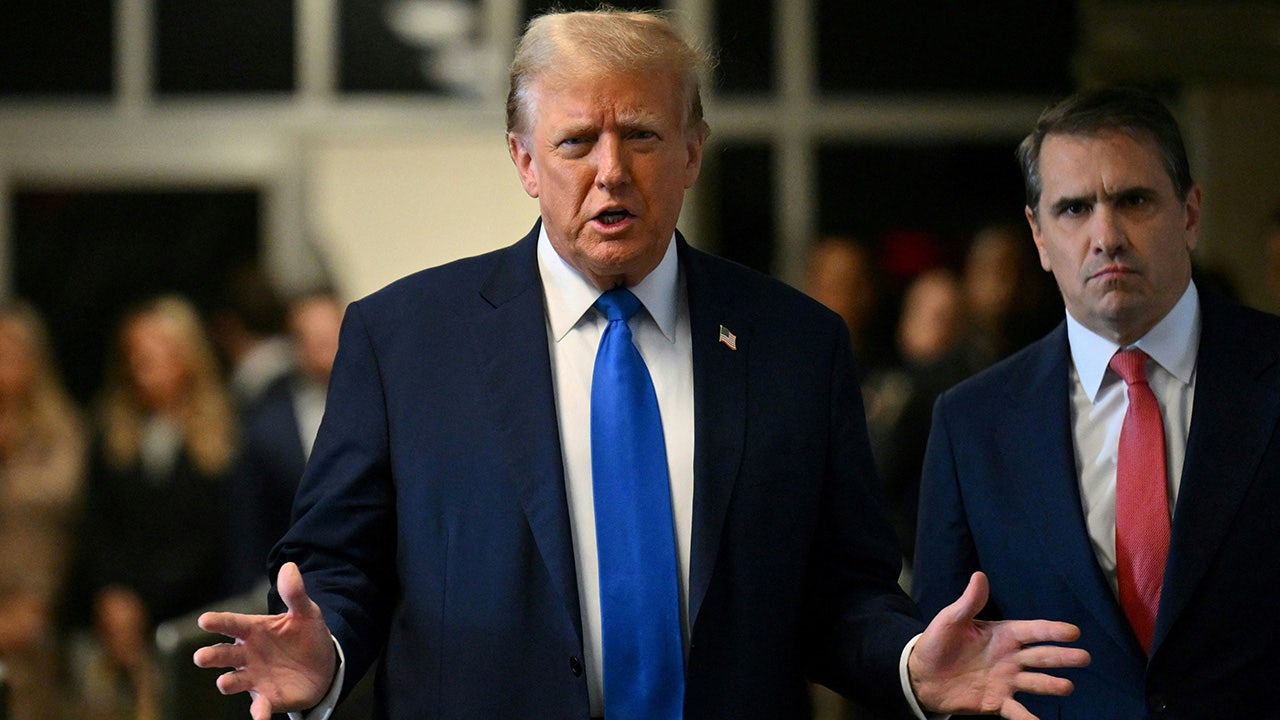Sports
Ferocious Oak Hill Daunts P.G.A. Championship Field, With More to Come

PITTSFORD, N.Y. — Scottie Scheffler had, at least in the moment, a share of the P.G.A. Championship lead when he offered a foreboding prediction Thursday afternoon: Oak Hill Country Club, already playing to the point of menace in the first round, would only become more terrorizing.
The winds are expected to bluster. Rain is coming. And, for good measure, the East Course has been recently restored to bring back the diabolical, century-old wizardry of the architect Donald J. Ross.
“It’s just one of those places where you hit one shot maybe barely offline, and sometimes can you hit a good shot and end up in a place where it’s pretty penalizing,” said Scheffler, the 2022 Masters Tournament winner, who nevertheless had his first bogey-free round in a major championship Thursday. “There’s lots of tough holes out there.”
The rough is showing itself to be ferociously retributive, the fairways so firm that balls are only so often staying in them — even after the frost that delayed Thursday’s start by nearly two hours had softened the turf. Rory McIlroy, the four-time major champion, hit two fairways all day as he dueled with crosswinds off the tees.
But there was no parade of aggrieved players publicly fuming over the setup just outside Rochester, N.Y. Instead, as the tight leaderboard took shape before play was suspended because of darkness, a brand of begrudging, knowing admiration took hold, even as the likelihood of a runaway winner seemed distant.
“Very difficult golf course,” said Bryson DeChambeau, whose four-under-par 66 put him in second place, one shot behind the solo leader Eric Cole, who did not complete his round on Thursday night. “As I was looking at it throughout the week, I’m like, man, I don’t know how shooting under par is even possible out here on some of the golf holes.”
“It’s playing tough,” said Kurt Kitayama, who was at even par. “I don’t think anyone’s really comfortable.”
“It stacks up with some of the toughest major championship venues that I have ever played,” said Corey Conners, who has had three top-10 finishes at the Masters, after his three-under-par round.
The sterling performance by DeChambeau, who has routinely sputtered since his 2020 U.S. Open victory in New York at Winged Foot, often seen as similar to the recharged Oak Hill, came after an early bogey on the 12th hole. (With a 156-man field, tournament organizers opted for a two-tee start. Because of the frost delay, the last group’s tee time was pushed back to 4:32 p.m., less than four hours before sunset.)
He moved to under par for the first time on his seventh hole — No. 16 — and finished his front nine at one under. Three birdies on his back nine, including one at No. 6, the hole that the course restorer Andrew Green has judged as Oak Hill’s most threatening, brought him to four under. Afterward, having become “so used to hitting it everywhere,” he reveled in a day of straight drives that, he conceded, could be little more than a memory by Friday evening.
“You always think you have it one day and then it just leaves the next,” DeChambeau said. “Just got to be careful.”
Scheffler, only a week removed from a round near Dallas in which he made birdie or eagle on five of his first six holes, found something approximating a groove on the par-5 No. 4. His tee shot rocketed wayward and landed miserably near a tree. He ultimately saved par anyway.
“We got a wind switch and had a really good up-and-down to keep the round going,” said Scheffler, who ended the day tied for third with Conners and Dustin Johnson, another Masters winner. “You would hate to bogey a par-5, especially when there’s only two of them around this place. That was good momentum.”
Cole, 34, charged up the leaderboard late in the day, when three consecutive birdies brought his score to five under. He had played in one other major in his career, the 2021 U.S. Open, where he missed the cut.
“When I did have an opportunity, I kind of felt like I happened to read it right and hit a good putt, and they went in today, so that was good,” Cole said Thursday night.
The first round, with 11 groups scheduled to resume play Friday morning, was more boggling for others.
There was Kazuki Higa, a Japanese golfer who missed the cut at the two other majors of his career, opening his day with birdies on four of his first five holes, only to end it with four consecutive bogeys or double bogeys. Jon Rahm, the No. 1 player in the Official World Golf Ranking and the winner of last month’s Masters Tournament, later finished at six over, the worst single-round showing at a P.G.A. Championship by a world No. 1 since 1987. And Brooks Koepka, who dueled with Rahm in the final round at the Masters but found himself with a two-over-par 72 on Thursday, said the first round “was the worst I’ve hit it in a long time.”
Jordan Spieth, who withdrew from a tournament last week because of a wrist injury, played Thursday and signed for three over, tying him with the past major champions Shane Lowry and Gary Woodland. McIlroy, who has lately struggled and missed the Masters cut, ended his day at one over. But his outing included an uphill putt from nearly 37 feet to save par at No. 2, delivering the kind of jolt that he suggested could perhaps keep him a contender.
“Depending on what happens over the next three days and what I go on to do, you know, I may look back at that shot as being the sort of turning point of the week,” he said.
The rigors of an event like this week’s helped shape Green’s thinking when he began work on the course, which hosted P.G.A. Championships in 2003 and 2013, as well as a Ryder Cup and three U.S. Opens.
“Knowing that the golf course has a wonderful major championship legacy, and knowing that was something the club wanted to continue to do, we had to blend the Donald Ross design elements with modern championship golf,” Green said in an interview this year.
The greens took on unorthodox shapes again, bunkers assumed greater brutality and more so-called chocolate drops — the turf-shrouded mounds that were a Ross signature — appeared.
“You play really well and hit fairways and greens, you can make some putts, you can shoot a few under par,” said Viktor Hovland, who finished at two under on Thursday. “But if you’re a little bit off, the rough is just so penal. If you are short or you make a couple bogeys, you want to attack the pin, and you hit it more in a bad spot and it’s just a never-ending cycle.”
The cut is scheduled for Friday evening, daylight permitting, with the top 70 and ties advancing to the weekend. Then the rain will start.

Sports
Lakers at a crossroads: What went wrong, what's next with LeBron James, Darvin Ham

Midway through the fourth quarter of a “road” game against the rival LA Clippers on Feb. 28, with the Los Angeles Lakers having cut a lead that was once as much as 21 points in the fourth quarter down to five, a question arose within the team’s player-led huddle.
Why are we running plays to have LeBron James attack a former Defensive Player of the Year in Kawhi Leonard if the Clippers are willingly switching big man Daniel Theis onto him in screening actions?
The answer, provided by multiple players whom team sources say spoke up in the huddle, would provide the key to that night’s comeback win in those final five-plus minutes.
Anthony Davis would set the high screen to prompt the switch, with D’Angelo Russell as the “high man” and Rui Hachimura in the strong-side corner. If a double-team came James’ way, Russell would flash across the lane and open up a potential dunk for Davis or a 3-pointer for Hachimura in the corner. The plan worked to near perfection, with Theis taking over for Leonard six times down the stretch and James picking the opposition apart from there as the Lakers finished the game on a 15-6 run to win 116-112.
During this fourth quarter, in which James scored or assisted on 11 of the Lakers’ 13 field goals, seven weeks after the job security of second-year coach Darvin Ham had become a major storyline of their season, the irony of the Clippers’ ending wasn’t lost on several Lakers players. They had, in their minds, won the game on their own.
It had been one step forward, two steps back for the Lakers over the two-plus months since their In-Season Tournament championship. But this, as some players saw it, was a sign of the locker room coming together in an attempt to salvage a challenging situation with the head coach with whom they often didn’t connect. Their self-empowerment, it seemed, was born out of the perceived absence of effective direction from the coaching staff.
This moment, one of many in which these Lakers felt compelled to find their own solutions, summed up a season that began with high hopes after their Western Conference finals appearance against Denver last year, but ended with another ouster at the hands of the Nuggets. And by the time the Lakers’ season ended in Game 5 against Denver on Monday night, when Jamal Murray’s second game-winner of the first-round series sent the Lakers home less than a year after the Nuggets swept them last May, there were strong signs within the organization that Ham would be deemed most responsible.
PLAYOFF. JAMAL. MURRAY.
His SECOND GAME-WINNER of the series sends Denver to Round 2 🚨 https://t.co/ZiNxo5iNc0 pic.twitter.com/b3AQoCUQIA
— NBA (@NBA) April 30, 2024
The Lakers’ unflattering finish leaves Ham’s future as head coach in serious peril, multiple league and team sources tell The Athletic, with some stakeholders indicating it’s highly unlikely he’ll return. The plan is to reassess everything that went wrong in the coming days before making a final decision. In 2022, Ham signed a four-year deal in the range of $5 million per season, so the team would be assuming the remainder of his deal if he is fired.
“It seemed like every time we hit a rhythm, somebody, a key piece, would fall out of the lineup. It is what it is, man,” Ham said after the Game 5 defeat. “I’m not going to feel sorry for myself, for ourselves. It’s an unbelievable franchise to represent. I couldn’t ask for a better governor, a better president of (basketball operations) in Rob Pelinka and Jeanie Buss. But I’ve seen a lot my first two years in this seat. I’ll continue to work, to get better and to control what I can control.”
The Lakers believed this roster was built for much more than a first-round defeat. Vice president of basketball operations and general manager Rob Pelinka and his staff retained key free agents, such as Austin Reaves, Russell and Hachimura, extended Jarred Vanderbilt and believed the core had promise to make a title run around Davis and James. Throughout the series and most of the season, however, team officials and players believe Ham’s fluctuating rotations, game plans and lack of adjustments led to an underperforming group. It created discontent within the locker room, which became palpable across the franchise.
The Lakers’ blown 20-point lead in Game 2 of the Denver series served as a final straw of sorts. After a successful first year as coach in which he showed signs as a leader of players, the tide turned for Ham this season. There was tremendous respect for Ham as a person, and players had an appreciation for his pro career and time as an assistant coach in Atlanta and Milwaukee. But, as one player said recently, “We need to be coached, too.”
Now, the Lakers face two franchise-defining questions.
Will LeBron stay in Laker Land?
LeBron James has a $51.4 million player option for the 2024-25 season. (Garrett Ellwood / NBAE via Getty Images)
Coming off his 21st NBA season, James is expected to play up to two more NBA seasons, one source briefed on his thinking said. He has a $51.4 million player option for the 2024-25 season. Two more seasons would take James through the 2026 All-Star Weekend in Los Angeles.
It’s anticipated James, ahead of his June 29 option date, will want to see how the Lakers manage the offseason and their approach to building the roster around him and Davis. Both routes — opting in and opting out — are on the table for James. He places importance on having comprehensive and well-rounded depth around him, which could mean the Lakers explore trades in the lead-up to that player option, sandwiched between the NBA Draft, which begins June 26, and the opening of free agency on June 30.
What’s more, team sources say the Lakers are very open to the prospect of helping LeBron fulfill his dream of playing with his son Bronny by potentially drafting him.
“My last year will be played with my son,” James famously told The Athletic in 2022.
LeBron changed his message in January 2023, telling ESPN that he would consider that family goal fulfilled so long as he shared the floor with Bronny “either in the same uniform or a matchup against him.” In the wake of Bronny’s cardiac arrest episode in July, he had an uneven freshman season at USC. His hard-to-handicap NBA future remains a topic of great debate, but rival teams believe it is not a matter of if he is a draft pick, but whether the selection range, location and fit are enough to keep him in the draft.
As for his father, the Lakers want him back — badly — and the potential of the 39-year-old LeBron returning remains the most likely scenario. Lakers owner Jeanie Buss, in particular, believes James’ return is of paramount importance to their plan. This franchise has always been buoyed by the stars, and James’ ability to still play at an elite level at his advanced age has only strengthened the desire to have him retire in a purple-and-gold jersey one day. And after six seasons together in which there has been no shortage of ups and downs, Buss and James, team sources say, have a relationship that is better than ever these days.
The Lakers, team sources say, would be open to discussing any deal that involves James coming back — including even the maximum three-year, $164 million extension they can offer. Playing through a three-year deal would put him at 42 by the end of the contract.
“He’s not the problem here,” one high-ranking Lakers official said of LeBron.
He is, in fact, still seen as a major part of the solution.
It bodes well for the Lakers that the relationship with James has stabilized in recent months. That didn’t appear to be the case in late January, when the Lakers fell below .500 with a loss to Atlanta and James’ hourglass tweet sparked so much speculation about his frustrations. Then, there were the series of pro-New York Knicks signals he sent out just days later during the team’s East Coast trip, all reminders that the leverage was his come summertime.
But when James chose not to engage with the Warriors at the trade deadline in February, with Golden State owner Joe Lacob known to have opened that door during a trade discussion that ESPN first reported, the Lakers saw it as a sign that he truly valued being part of the Lakers organization. A month later, James’ cordial courtside visit with Buss and her longtime Lakers partner Linda Rambis was as good a sign as any that all was well in their relationship. But James has made a habit of keeping his options open for most of his storied career, and this time around will be no different.
“I just want to get home to the family,” James said after Game 5 when asked about his future. “Honestly, one of my boys is trying to decide if he’s going to enter the draft or go back to school. Another kid is playing AAU ball right now. My daughter is playing volleyball. My wife is doing so many great things. So it’s about family right now. Then, in a couple months, I got to go to Vegas for training camp. So I need to rest my body for (USA Basketball).”
“I’m not gonna answer that,” he said later when asked if he thought Game 5 might have been his last game as a Laker. “I appreciate it.”
The Lakers are expected to be aggressive in the market, with Atlanta’s Trae Young one of the more intriguing names out there. The Lakers’ room could be split on him as they try to make the most of this precious time in which James and Davis are still playing at an elite level. He’ll be one of many names that is expected to be discussed.
The team needs backcourt help, particularly after Russell’s up-and-down play against the Nuggets for a second consecutive season. His performance leaves a significant question about his likelihood to return, even with an $18.7 million player option for next season. The Lakers will be armed with three first-round draft picks eligible to be moved on draft night, plus tradeable contracts tied to Reaves, who has strong value across the league, and Hachimura.
Where did Darvin Ham go wrong?

Darvin Ham’s relationship with the Lakers’ players deteriorated over the course of the season. (Jerome Miron / USA Today)
In the eyes of the Lakers’ top decision-makers, the combination of last season’s West finals appearance and December’s In-Season Tournament championship were signs this roster was worthy of contention. The pressure was on Ham to make the most of it. But just as the momentum started to build, with the stability the organization had longed for in Ham’s tenure within reach, the Lakers’ skid began.
They lost 10 out of 13 games after the In-Season Tournament, with two four-game losing streaks during that stretch and losses to teams such as San Antonio, Chicago, Memphis and Miami (without Jimmy Butler) that they would later pay so dearly for in the standings. The disconnect between Ham and his locker room was detailed by The Athletic in an early January report, but the ownership support that he spoke openly about at the time played a pivotal part in the organization’s choice to continue with him on the bench.
The Lakers were largely healthy during that stretch — only Russell (four games) and Gabe Vincent (12 games) missed notable time from their normal rotation. Outside of that period, the team went 44-25, a 52-win pace. If the Lakers had won a few more of those games during that stretch, they would’ve finished at least sixth in the West, which would’ve kept them out of the Play-In Tournament and from facing Denver in the first round.
During the 13-game skid, the Lakers used six starting lineups, including two variations of an all-wing lineup — James, Davis, Taurean Prince, Vanderbilt and either Cam Reddish or Hachimura — for five games (the team went 2-3). The decision to bench both Reaves and Russell, the team’s consensus third- and fourth-best players, did not sit well with many within the organization and locker room, according to team and league sources.
Ham’s decision was viewed as a panic move that backfired, a divergence from the team’s stated goals of developing reps and continuity with the core players and groups from last season. Instead, those lineups and groupings didn’t play as much as they could have, even as bench or closing lineups.
Before Hachimura became the full-time starter on Feb. 3, he had only played alongside James, Davis, Reaves and Russell in six of a potential 26 games. Vanderbilt only played 32 minutes alongside James, Davis, Reaves and Russell.
Injuries played a role, too. Vanderbilt missed 53 regular-season games due to injuries. Vincent missed 71. Christian Wood missed the final 26 games after the All-Star break. Hachimura missed 14. At the same time, the Lakers’ four best players – James, Davis, Reaves and Russell – each played in at least 71 games. Ham avoided those lineups — mainly Vanderbilt and Hachimura alongside James and Davis — for reasons that are still unclear.
The buzzword of the Lakers’ offseason and training camp was continuity. The Lakers believed their supporting cast around James and Davis — specifically, Reaves, Russell, Hachimura and Vanderbilt — complemented the stars and one another well. All four players were in their mid-to-late 20s and under contract for at least one additional season. The plan was for the Lakers’ core to be those six players plus Vincent.
Four of the five starting spots were cemented: Russell, Reaves, James and Davis. The fifth spot was going to be decided in training camp, with Vanderbilt, the incumbent starter entering the 2023 postseason, the front-runner to retain his starting spot. But things went awry when Vanderbilt suffered a heel injury during the first preseason game.
That led to Ham and the coaching staff starting Prince, who had been signed to a one-year, $4.5 million contract as a 3-and-D wing and was viewed as the likely eighth or ninth man. Prince inadvertently became the avatar for the Lakers’ issues, as his outsized role often came at the expense of the core players and led to smaller lineups, which performed worse statistically. The Lakers were just 24-25 with Prince as a starter and 28-8 in the 36 games he played fewer than 25 minutes (he missed four games due to injury). He finished last on the team in plus-minus in the regular season.
There was a sense among people within the organization that Prince and Reddish — a 24-year-old minimum contract signing — were given opportunities to fail and play through their mistakes during the regular season, a luxury that Reaves, Russell, Hachimura and others weren’t afforded.
The confusion toward Ham’s rotation even included his decision to split minutes between Vincent and February post-buyout signing Spencer Dinwiddie in the final weeks of the regular season and playoffs. This broke the rhythm of Dinwiddie as the primary backup guard — as he shot 39.7 percent from 3-point range and was among the team’s plus-minus leaders after joining — and led to the question as to why the staff did not elect to go all in with one of them instead of attempting to force small stretches for each.
The injuries to Vanderbilt and Vincent certainly hindered the rotation, but the benchings of Reaves, Russell and Hachimura, and the increased roles of Prince and Reddish, led to the question that would hurt Ham’s standing in the end: What might have happened if the Lakers simply played their best players from opening night?
After they moved Hachimura into the starting lineup, the Lakers closed the regular season 19-6, a 62-win pace. They had the fourth-best record in the West and fifth-best in the league after Feb. 1. They also posted the league’s third-best offense over that stretch. That success, however impressive, was seen by some as an indictment of Ham’s rotation choices that had come before it.
The frustration, which was sometimes so apparent that even opposing players would be made aware of it while sharing the court with the Lakers, didn’t stop at just the lineups and rotations. Players openly criticized Ham’s willingness to allow below-average shooters to get wide-open 3s and believed the team was slow to adjust once a poor shooter was in a rhythm.
“Everybody, no matter what their numbers are, shoots well against us,” Davis said on Jan. 11 after an 18-point loss to the Phoenix Suns. “If a guy is shooting 10 percent, he’s gonna shoot 40 (percent) against us. Just knowing that. There hasn’t been a time where the numbers have told the truth to us when we’ve played guys.”
Ham often referenced “the numbers” supporting the Lakers ignoring or aggressively helping off certain shooters.
During the regular-season matchups with the Nuggets, players privately complained about not feeling prepared for Denver’s late-game offense. Those criticisms continued into the playoffs, leading to an awkward back-and-forth between Davis and Ham between Games 2 and 3.

Darvin Ham’s response to Anthony Davis’ comments after Game 2 of the Nuggets series was another flashpoint in the season. (Garrett Ellwood / NBAE via Getty Images)
In Game 2, Davis had a career-best playoff half, making 11 of his first 12 shots. Overall, he made 14 consecutive field goals after missing his first. But after the Nuggets called timeout, trailing by 20 points with 10 minutes remaining in the third quarter, they made an important defensive adjustment that would alter the course of the game and, ultimately, the series.
They changed Nikola Jokić’s defensive assignment from Davis to Hachimura, which, in turn, moved Aaron Gordon from James to Davis and Kentavious Caldwell-Pope from Russell to James. Davis only went 1-of-5 the rest of the game, largely standing in the corner as the Lakers instead chose to run James-Hachimura pick-and-rolls to target Jokić.
Following the loss, Davis called out the team’s in-game execution.
“We have stretches where we just don’t know what we’re doing on both ends of the floor,” Davis said. “And those are the ones that cost us.”
Though it was a general criticism that appeared to be addressed to both teammates and coaches, Ham defended himself and the coaching staff when asked about the comments at the next practice.
“I mean, I just think sometimes when plays don’t turn out the way you think they should, then the frustration sets in a little bit,” he said. “But I don’t think it’s [from] us not being organized. I think I have incredibly talented coaches all along my staff. We pride ourselves, whether it’s a practice, a shootaround, a film session, a game or whatever, we pride ourselves on being highly efficient and organized. I just chalk that up to being frustrated. It’s an emotional game, the way it ended and all of that. But I’ll agree to disagree on that one.”
Ham’s response was viewed as an unnecessary amplification of Davis’ comments, according to team sources. Ham could have downplayed the remark or even agreed with his superstar’s criticism of the team’s execution after that blown 20-point lead. But Ham instead talked up his coaching staff and dismissed the sentiment behind Davis’ comments as simply frustration. The notion of engaging in a public back-and-forth with a franchise cornerstone in Davis, who signed the richest annual contract extension in league history in early August, was seen internally as ill-advised.
There was a sense internally that while Ham didn’t always need to win the news conference, he was far too often losing it.
Following the Lakers’ Jan. 5 loss to the Grizzlies, their fourth consecutive loss to begin 2024 that dropped them to 17-19, Ham said, “I’m tired of people living and dying with every single game we play. It’s ludicrous, actually. It’s like, c’mon, man. This is a marathon.” The ethos of that quote did not sit well with the fan base, which became increasingly critical of Ham during the season. As Game 3 against Denver at Crypto.com Arena wound down and the Lakers fell down 3-0 in the series, a segment of Lakers fans started chanting “Fire Darvin!” twice.
And players took notice of the public comments, as well. They eventually responded with subtle barbs of their own, noting the team’s lack of preparation for certain players and schemes and repeatedly complimenting opposing coaches and talking up their adjustments.
“We’re a team that we do a lot of things on the fly,” Russell said at practice after Game 2. “We adjust, and we go from there. A lot of the stuff that we’re doing is stuff that we’re not familiar with either. We don’t prepare for Jokić every game. So for us, it’s something that we’re trying and figuring out as we go.”
In the eyes of several team sources, Ham rarely, if ever, publicly cited the fault of his schemes, game planning or rotations. Ham and his representation did not respond to a request for comments for this story.
“I’ve always thought that a team is the reflection of its coach in terms of the mental stability, the emotional stability,” Ham said before Game 3.
That comment might prove prescient in the worst of ways for Ham, the former player who came the Lakers’ way after 11 years as an assistant and was faced with the immediate pressure to lead the franchise to its 18th title. That’s the harsh reality of being a coach on a LeBron James-Anthony Davis team, and Ham’s inability to push the program in that direction has caused serious angst from the top of the organization on down.
“It’s been a hell of a two years sitting in this seat, I’ll tell you that,” Ham said after Monday’s Game 5 defeat. “It’s been a hell of a two years.”
The Lakers’ most powerful people don’t like what they see in the mirror right now, and so another offseason of hard decisions awaits.
(Illustration by John Bradford / The Athletic. Photos via Garrett Ellwood, Justin Ford and Garrett Ellwood / Getty Images)
Sports
Carolina Hurricanes limiting playoff ticket sales vs Rangers to local residents
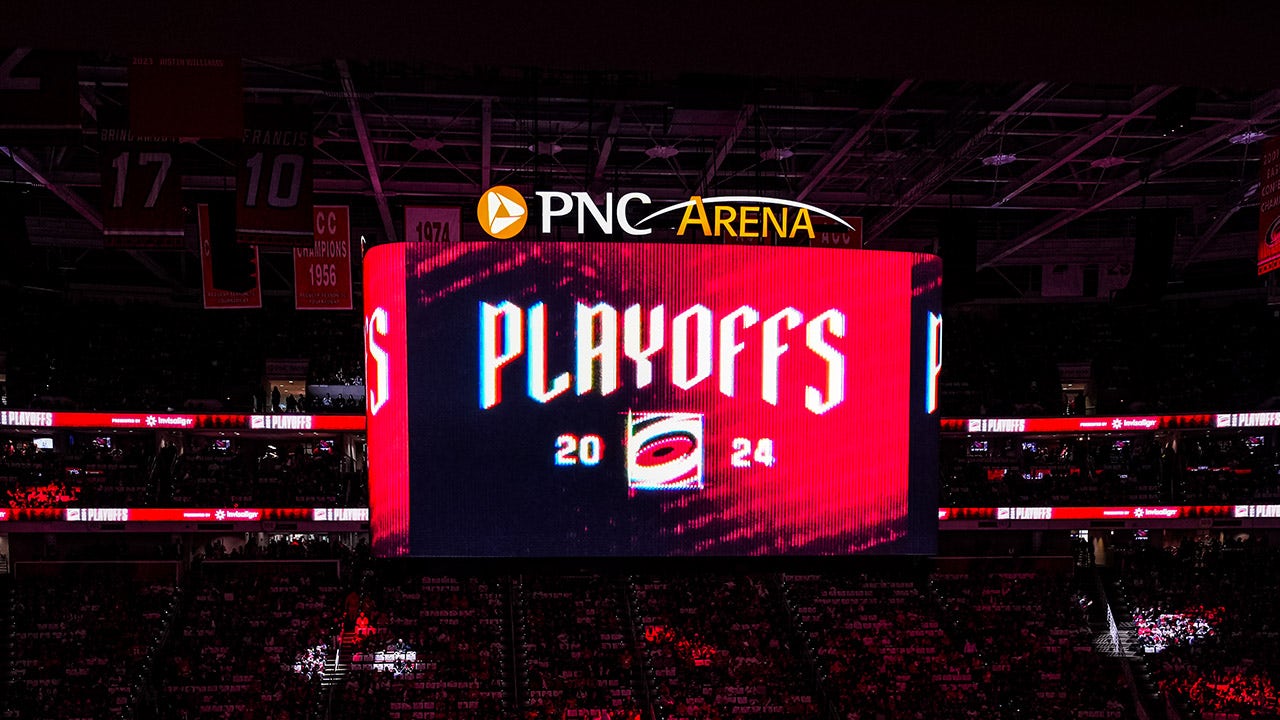
The Carolina Hurricanes are going the extra mile to make sure they have home-ice advantage in the second round of the Stanley Cup Playoffs.
The Hurricanes got a tough draw for the second round in facing the Presidents Trophy winner in the New York Rangers.
Despite that, Carolina actually is favored to not only win the series but win the Cup.
(Cato Cataldo/NHLI via Getty Images)
But the Rangers fan base is one of the largest out there. And the ‘Canes know that.
So, they are limiting ticket sales for their home games of the series to only local residents.
“PNC Arena is located in Raleigh, NC. Sales to this event will be restricted to residents of North Carolina, South Carolina and southern parts of Virginia,” says a disclaimer on social media. “Residency will be based on credit card billing address. Orders by residents outside North Carolina, South Carolina and southern Virginia will be canceled without notice and refunds given.”
Carolina hosts Games 3 and 4 of the series, and if necessary, Game 6.
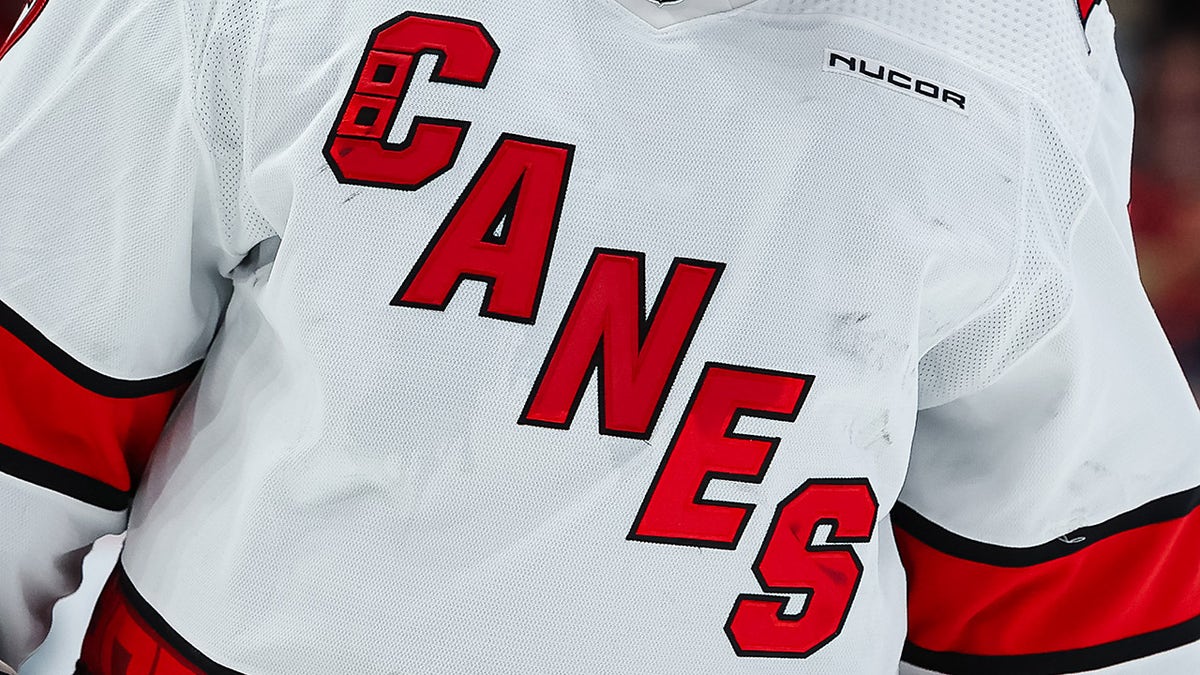
The Carolina Hurricanes are limiting ticket sales to local residents for home games in the playoff series against the New York Rangers. (Scott Taetsch/Getty Images/File)
LIGHTNING COACH APOLOGIZES FOR SAYING GOALIES ‘MIGHT AS WELL PUT SKIRTS ON’ AFTER BACKLASH
Rangers fans aren’t the only fan base from Madison Square Garden to recently be shut out of an opponent’s arena.
Philadelphia 76ers co-owners Josh Harris, David Blitzer and David Adelman, along with Fanatics CEO Michael Rubin, purchased 2,000 tickets to Thursday’s Game 6 in Philadelphia to give to local first responders and community groups.
That gesture came after Sixers star Joel Embiid turned heads when he said he was “disappointed” that New York Knicks fans had seemingly taken over Wells Fargo Center in Game 4. Rubin joked on X, formerly Twitter, that Philly fans “absolutely CANNOT let Knicks fans take over our arena again!!!”
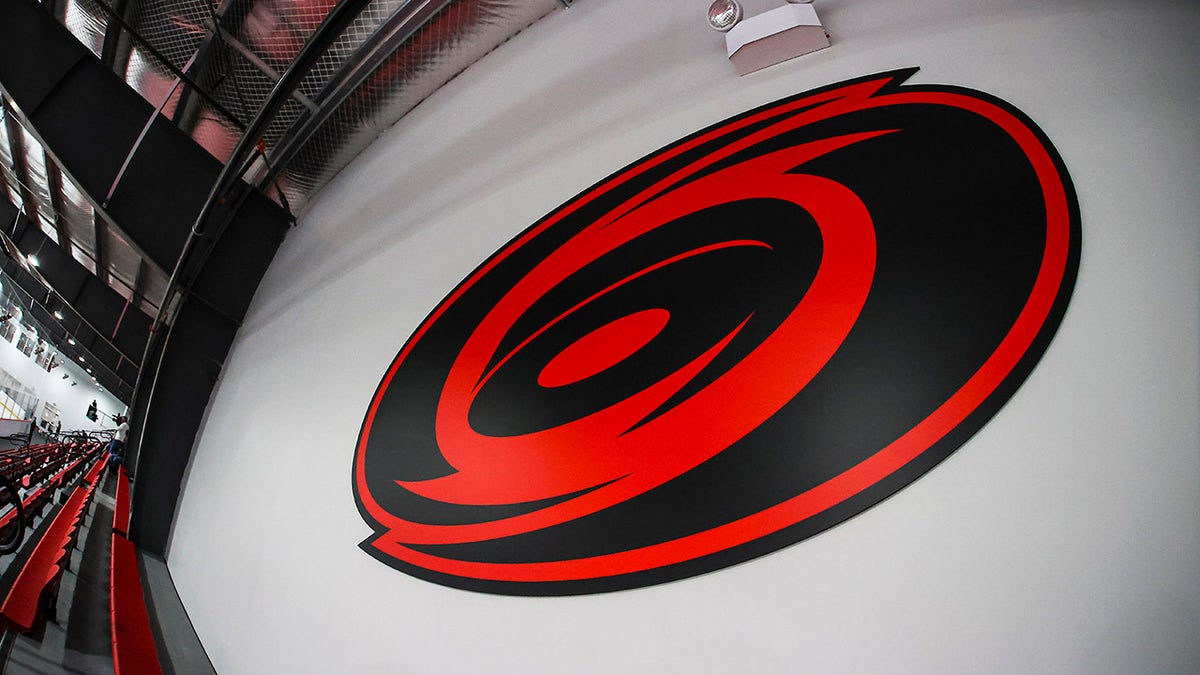
The Carolina Hurricanes are limiting ticket sales to local residents for home games in the playoff series against the New York Rangers. (Jaylynn Nash/Icon Sportswire via Getty Images via Getty Images/File)
Madison Square Garden prices tend to be higher than most, especially during the playoffs, so it makes sense why fans opt to travel, especially to Philadelphia, which is just a trip down the New Jersey Turnpike.
The dates for the series are still to be determined.
Follow Fox News Digital’s sports coverage on X, and subscribe to the Fox News Sports Huddle newsletter.
Sports
How hitting with runners in scoring position has been Shohei Ohtani's one Dodgers flaw
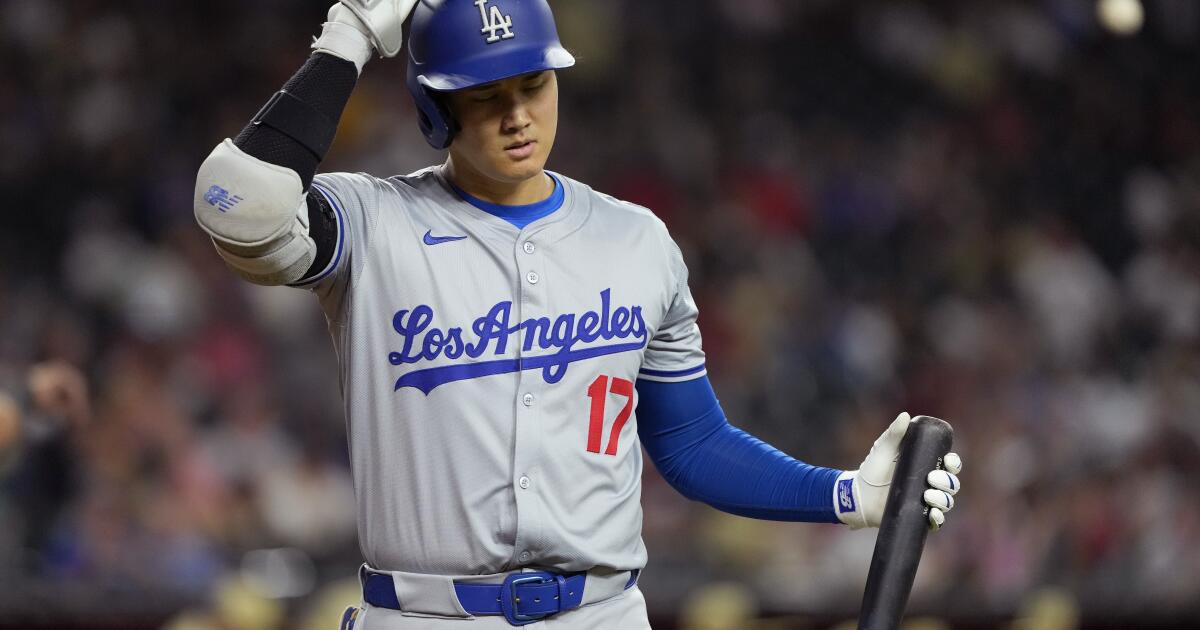
The timing was coincidental.
But, on Shohei Ohtani’s first off day as a Dodger, the discourse Wednesday centered on the one big struggle of his 2024 season — a weakness that had cropped up once again the night before.
When there hasn’t been a baserunner at second or third base season, Ohtani has been the best hitter in baseball. He is batting an MLB-best .398 in such spots. His .774 slugging percentage is more than 100 points better than all but two other players.
When the Dodgers need to start a rally, the $700 million signing is often their most potent spark.
However, with runners in scoring position over the first month of the year, the slugger’s production has unexpectedly cratered, leading to a trend of frustratingly empty key at-bats.
With RISP, Ohtani is batting just .184 (seven for 38) with a .237 slugging percentage. Of the 14 big leaguers with at least 35 such at-bats, he is the only one with less than 10 RBIs. And, somewhat amazingly, he has driven more runs without RISP (10, including all seven of his home runs) than with RISP (nine).
The two latest examples came in a Tuesday loss to the Arizona Diamondbacks, when Ohtani struck out in the fifth inning with runners on second and third, then almost hit into an inning-ending double-play in the top of the 10th, having to use his speed to beat a throw to first and prolong the inning — one that still resulted in only one Dodgers run, before the Diamondbacks scored twice in the bottom half for a walk-off win.
“Certainly, there was some opportunities,” manager Dave Roberts said a day later, after — in what he insisted was an unrelated decision — deciding to give Ohtani his first day off. “But, I don’t want to say [it was him taking a] step back.”
Maybe in the context of this season, it wasn’t.
But, compared to his past three seasons with the Angels, when producing in situational at-bats was one of the two-time MVP‘s signature strengths, Ohtani’s struggles this year have thus far been confounding.
From 2021-2023, Ohtani was one of MLB’s best hitters with RISP. He batted .305 in those situations, the 22nd-best mark in the majors in that span. He slugged .689, easily the best mark among big-league hitters.
On the surface, the explanations for this year’s regression seem simple.
Compared to his non-RISP at-bats, Ohtani swings more frequently (56% with RISP, 43% without) and chases more often (31.5% with RISP, 26.5% without) with a chance to drive in runs.
It has led to shorter at-bats (he sees 3.5 pitchers per plate appearance with RISP, and 4.2 without) and, despite a decreased in strikeouts, an also slightly lower walk rate (9.1% with RISP, 10.5% without).
Whenever he does come up empty on a pitch outside the strike zone, it’s easy for fans and media members to identify in real-time.
“Shohei is as aggressive as those bees were,” Roberts said, jokingly referring to the swarm of bees that delayed Tuesday’s game. “Hitters [like him] want to hit … They want to hit in big spots.”
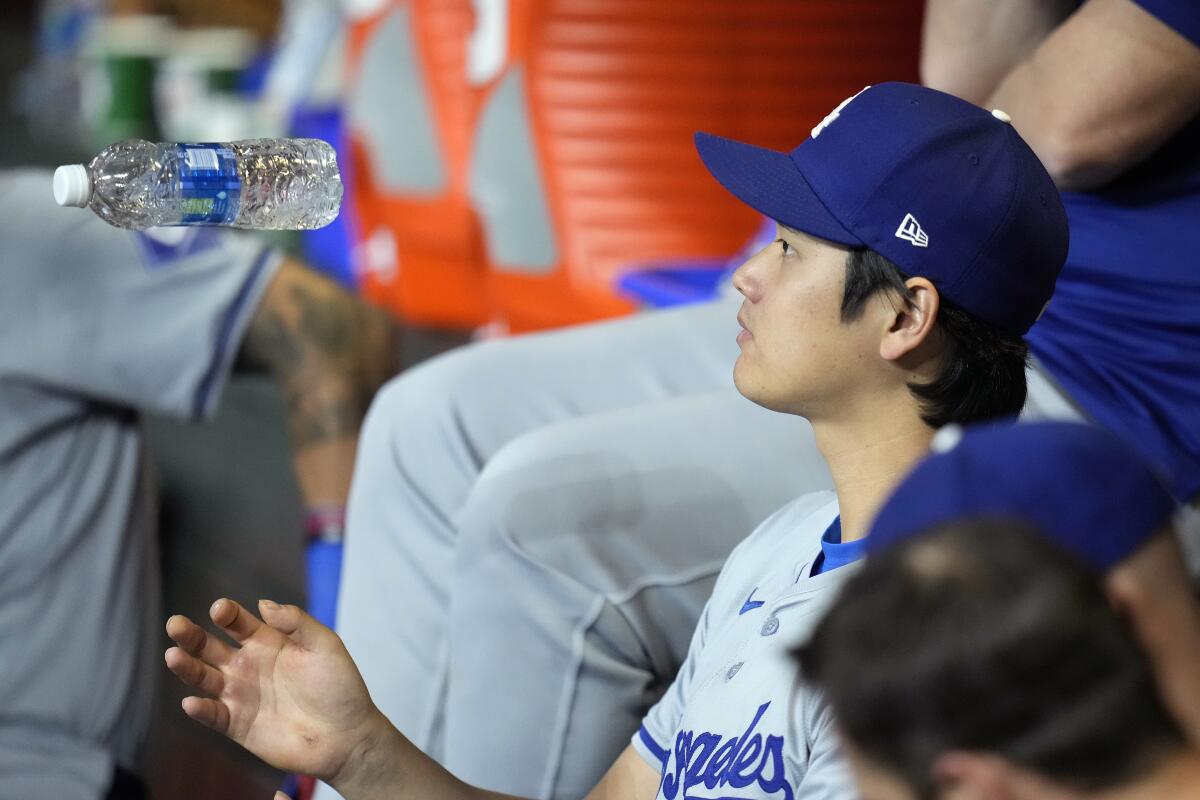
Shohei Ohtani was given a day off for the first time this season, though Dodgers manager Dave Roberts was quick to point out it wasn’t because of his struggles with runners in scoring position.
(Ross D. Franklin / Associated Press)
It’s just that, this year, he almost seemed to want to do so too badly too many times.
There is an important caveat to all this, though: Ohtani’s approach with RISP this year hasn’t seemed to differ much from what he did in Anaheim.
From 2021 to 2023, Ohtani swung with RISP almost 53% of the time, only slightly less than this year. He would chase pitches at a 35% rate, slightly more often than the opening month of this season.
Such aggression is evidently by design. When asked about his RISP approach a couple weeks ago, Ohtani acknowledged through his interpreter that “the zone that I am swinging is a little bit larger with runners in scoring position.”
Opponents, after all, are more likely to pitch around him with RISP. If he wants to “move the ball forward,” as Roberts likes to say, it requires hitting pitches not directly over the heart of the plate.
“Certainly,” Roberts said, “he feels like he’s the best option to drive in a run.”
Of course, as the manager conceded, that does give pitchers a way to exploit Ohtani, tempting him with offerings out of the zone he sometimes shouldn’t be chasing.
Yet, at the same time, Roberts said, “I think his DNA … is to want to swing the bat.” Which, in the manager’s opinion, “is still a good thing.”
So how does Ohtani get better with runners in scoring position?
Given his track record, the answer might not be as obvious as being more selective with his approach at the plate.
Sure, Roberts said, Ohtani needs to keep improving his plate discipline — a trait he has highlighted as a key to the slugger’s strong start to the year overall.
But, just as important, is for Ohtani to simply execute better when swinging outside the zone, and replicate the productive aggressiveness he honed in years past.
That could mean more consistency with his mechanics. It could mean trying to hit the ball the other way more often, something he has not done nearly as much with RISP this year compared to the past.
Whatever the case, his approach in clutch moments will continue to attract scrutiny — serving as the one place this year to poke holes in his game.
“I did see some more expanding than he has done in let’s say the last, seven to 10 games,” Roberts said of an ever-evolving process. “But I think in general, he’s been in a good spot.”
-

 News1 week ago
News1 week agoLarry Webb’s deathbed confession solves 2000 cold case murder of Susan and Natasha Carter, 10, whose remains were found hours after he died
-

 Education1 week ago
Education1 week agoVideo: Dozens of Yale Students Arrested as Campus Protests Spread
-

 World1 week ago
World1 week agoHaiti Prime Minister Ariel Henry resigns, transitional council takes power
-

 News1 week ago
News1 week agoFirst cargo ship passes through new channel since Baltimore bridge collapse
-

 World1 week ago
World1 week agoUS secretly sent long-range ATACMS weapons to Ukraine
-

 World1 week ago
World1 week agoSpanish PM Pedro Sanchez suspends public duties to 'reflect'
-

 News1 week ago
News1 week agoAmerican Airlines passenger alleges discrimination over use of first-class restroom
-

 World1 week ago
World1 week agoAsia bears biggest climate-change brunt amid extreme weather: WMO

